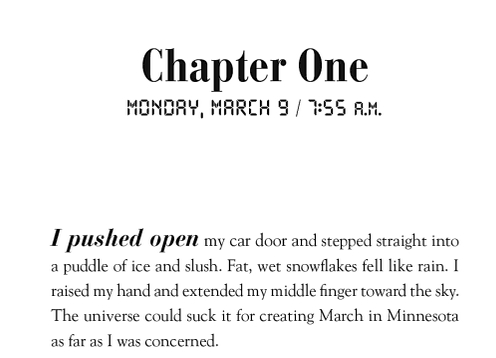
Lara Zielin’s The Implosion of Aggie Winchester and the Relationship Between Plot and Character
Aggie Winchester dresses like a Goth and engages in modest rebellion with her best friend Sylvia. As the novel opens, in fact, she and Sylvia are about to skip school to get their eyebrows pierced. Aggie’s mother is the principal of her high school, which only complicates things further. The book has two inciting incidents, really: Sylvia reveals that she is pregnant and Aggie’s mother discloses that she has breast cancer.
Through the course of Lara Zielin‘s novel, young Aggie does quite a lot. She copes with her mother’s illness, her ex-boyfriend’s emotional manipulation, the heartbreak of bass fishing, the duplicity of the mainstream media and more. This coming-of-age story ends, of course, with Aggie coming of age and engaging in the identity formation that is one of the purposes of adolescence.
Ms. Zielin is obviously very much interested in her characters, but the book seems to be to be heavier on plot than a lot of books I have read recently. There’s a lot going on:
- Aggie’s tattered relationship with Neil
- Aggie’s strained relationship with Sylvia
- Sylvia’s pregnancy and her desire to have Ryan acknowledge it
- The health scare Aggie’s mother is enduring
- The prom king and queen election and its many…irregularities
- The bass fishing tournament
- The general population of St. Davis High already dislikes Aggie to some extent…then has reason to dislike her further
There are a lot of balls in the air in this novel! I find this interesting because I think we’re in a time when plot is slightly less in vogue in many quarters in favor of characterization and other implements in our writers’ toolbox. Here’s what is crucial about Ms. Zielin’s decision to go full speed ahead with plot: the plot is contrived in such a way that it emerges from and reflects upon her characters.
Think about it. Sylvia slept with Ryan and wasn’t vigilant about protection, which resulted in her pregnancy, which exacerbated her need to bring Ryan closer, which made her feel it necessary to do what she did with respect to the prom elections. The pregnancy also served to push Aggie away, which added to her stress levels and also inspired Aggie to do certain things. (I don’t want to give away the whole book!) Ms. Zielin’s characters are both citizens in and creators of the world they inhabit, as should be the case for most of our characters.
How do we know who we truly are? As you have surely heard before, character is who we are in the dark. The way we think and behave when we’re not being watched. Most people, of course, contrive their actions to mollify others, particularly young people like Aggie Winchester and her friends. Aggie’s journey, comprised of the many, many obstacles she faces, results in Aggie exposing more of her actions and thoughts to the light, dismissing what others might think of her.
Ms. Zielin does something with the narrative that I think is interesting. Each chapter is time-stamped like so:
 I find the technique interesting because I puzzled over the same issue as Ms. Zielin did when I wrote the YA book I recently completed. How do you depict the passage of time in a way that is simultaneously natural and obvious? A lot happens to and for Aggie between March 9 and May 2…how do you keep the focus on the events themselves and not what the calendar says? Sylvia is pregnant, which adds additional pressure to keep the calendar pages straight; that baby is a-coming out nine months after it was conceived and there are several well-documented and inviolable developmental steps in between. (You can’t have a mother showing when the baby is two months along.) The dates and times, I guess, are great for some readers, but I don’t think I needed them.
I find the technique interesting because I puzzled over the same issue as Ms. Zielin did when I wrote the YA book I recently completed. How do you depict the passage of time in a way that is simultaneously natural and obvious? A lot happens to and for Aggie between March 9 and May 2…how do you keep the focus on the events themselves and not what the calendar says? Sylvia is pregnant, which adds additional pressure to keep the calendar pages straight; that baby is a-coming out nine months after it was conceived and there are several well-documented and inviolable developmental steps in between. (You can’t have a mother showing when the baby is two months along.) The dates and times, I guess, are great for some readers, but I don’t think I needed them.
The times and dates do, however, function as a grounding device in the same manner as the ones used in It’s Always Sunny in Philadelphia. Each episode of that show begins with title cards like these:
 In this way, Ms. Zielin reminds the reader that her story is taking place in a world that the reader can recognize, even if the precise date and time don’t matter. Even though Aggie and her mother and Sylvia are going through an exceptional series of events, the kind of confluence of events to which few of us can relate, the chapter title timestamps are subliminal reminders that this world really isn’t that different from our own. Even if the reader skips over them, he or she doesn’t get lost in the narrative and they take precious little page space, so…why not?
In this way, Ms. Zielin reminds the reader that her story is taking place in a world that the reader can recognize, even if the precise date and time don’t matter. Even though Aggie and her mother and Sylvia are going through an exceptional series of events, the kind of confluence of events to which few of us can relate, the chapter title timestamps are subliminal reminders that this world really isn’t that different from our own. Even if the reader skips over them, he or she doesn’t get lost in the narrative and they take precious little page space, so…why not?
Just before the release of the book Ms. Zieling offered us an important lesson in how we deal with the manner in which our work is received. The person who reviewed The Implosion of Aggie Winchester for Kirkus didn’t particularly care for it. That’s okay, I suppose. We know what they say about critics. Writers (and agents and editors) are human, of course, and our hearts can’t talk our minds out of completely dismissing a negative review. Ms. Zielin, who seems like a fun and kind person, allowed her friend to turn the review into a heavy metal song. The lesson seems to be that writers have no way to avoid rejection and negativity, so we must do what we can to take it in stride.


